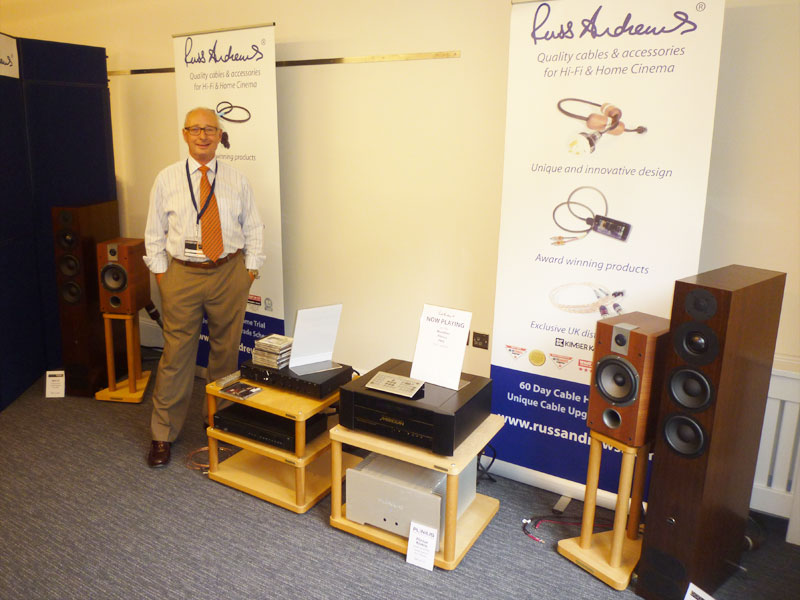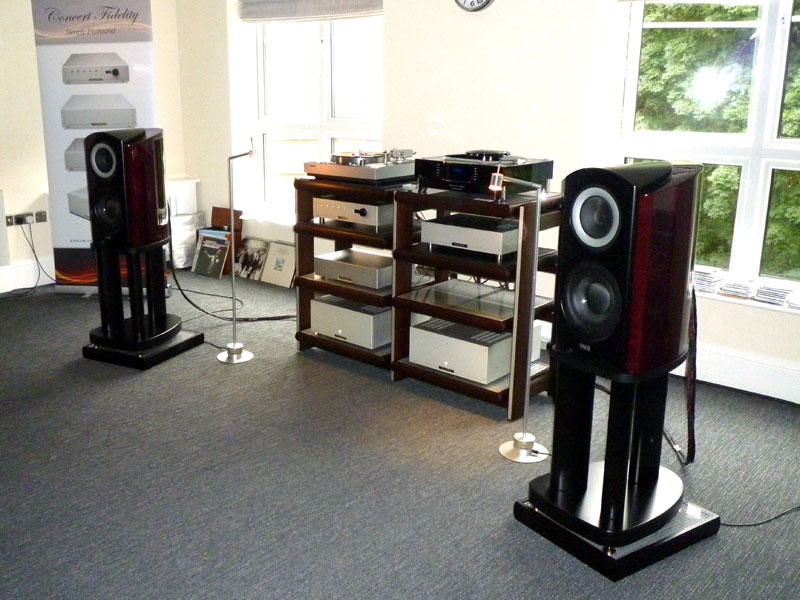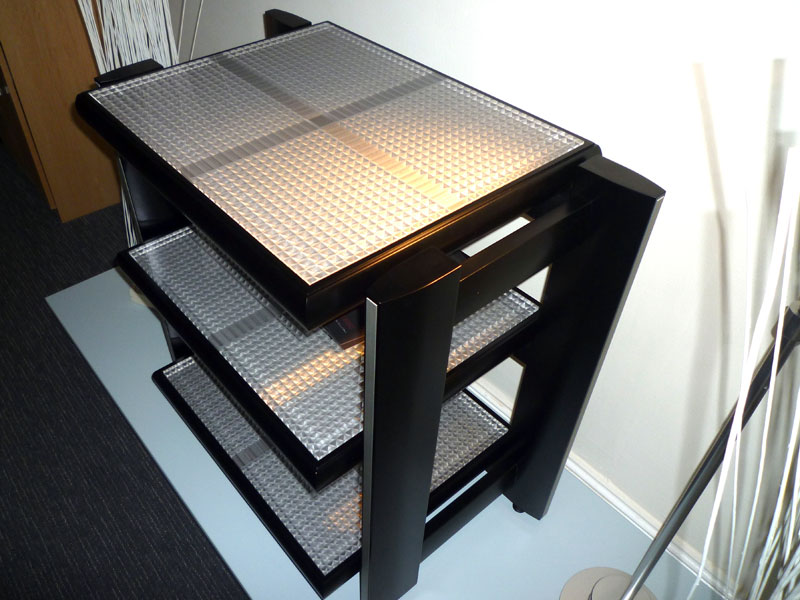National Audio Show 2013 • The Road to Nowhere
Another year, another September show: the UK’s traditional “season starter” might never have had quite the same razzmatazz as the first pitch, but it always used to spark a tingle in the nerve endings, a frisson of optimism after the lazy days of summer. Set against the backdrop of a clingingly persistent recession and an upstart alternative show, this year's National Audio Show (NAS) had its work cut out before it even started. Under the circumstances, just keeping its head above water would constitute a positive result -- and that it certainly did. On paper, the NAS has a lot going for it: the right time slot, a geographically central, rural location with a range of large, solidly constructed rooms, plenty of free parking and the facilities of a serious hotel on tap. But that’s all on paper; the reality has proved to be rather different. The hotel, Whittlebury Hall, has been having its own financial problems in the last few years -- problems that are all too apparent in the cost and quality of the services and restaurants. The quiet location means that there are few alternatives when it comes to eating or accommodation, and the peace is marred by the proximity of the Silverstone racing circuit -- there’s nothing quite like a SuperBikes weekend to make sure that exhibitors keep their windows closed. It’s a pain to get to unless you are driving, despite the best efforts of the organizers when it comes to shuttle buses and the like. The hotel itself is something of a rabbit warren, making any systematic approach to the show almost impossible. None of which would matter if the rooms sounded great, but for the most part they don’t. Now, credit where credit’s due, that is down in no small part to the exhibitors themselves. The range of room dimensions available is impressive, but too many of them are large, solid and incredibly sparsely furnished. If ever rooms needed treatment, these are them -- but in a bizarrely ironic twist, acoustic treatment is and always has been a UK blind spot. Throw in falling exhibitor numbers and the end result is too many exhibitors with systems rattling around in huge spaces that they are ill-equipped to furnish, dress or deal with. The availability of those spaces is itself a telling factor. The rumblings of discontent that I chronicled last year have bubbled to the surface in the shape of an alternative event positioned towards the end of October, ostensibly a reader show for Hi-Fi News magazine. Take a look at the list of absentees I compiled for last year’s NAS (pretty much a complete directory of the admittedly self-appointed great and good of the UK industry) and compare it to the exhibitor listing for this new event and the reality becomes clear. Given that the NAS usurped the position of the previously well-established HFN/RR event and the opportunity for a little payback becomes too good to miss. Given that the original show foundered on the title’s inability to keep the commercial and political imperatives of the event separate from the editorial policy and content of the magazine, it’s the sort of naïve and simplistic power grab that would make a third-world dictator blush -- and which they may yet come to regret. With all that festering in the background, I’ll admit that it was with a heavy heart that I set out on my journey to Whittlebury Hall. Perhaps it was the weather, perhaps it was the company, but as events turned out, I spent a far more enjoyable and productive day than I anticipated. The show has shrunk still further, compared to exhibitor numbers last year. The venue is still creaking, while the lick of fresh paint has served to sharpen up the slap echo, but the exhibitors themselves were notably more upbeat and visitor numbers seem to have stabilized. The organizer’s figures suggest a 25% increase, but I think that that is best considered optimistic, probably to be filed under the general heading of “lies, damned lies and show stats.” Exciting new products were fairly thin on the ground, and some of the sound was genuinely "Duck For Cover" bad, but what I did see was people making an effort -- and by and large the visitors I spoke to were appreciative of the fact. There were two rooms that really caught my attention, the first because it maintained a tradition that’s close to my heart: the idea that in going to a show you should set out to actually demonstrate something. The idea of placing a system in a hotel room and then simply playing music has never, ever made any sense to me, but it’s amazing how many companies confine their activities to exactly that -- with predictably disappointing and ineffective results. There are a number of reasons why audio shows in the UK have been in steady decline, but this is one of them. The sheer lack of ambition (and in many cases, competence) that it displays would be remarkable if it wasn’t overshadowed by a refusal to recognize the realities of the situation that borders on denial.
So the Russ Andrews room came as a serious breath of fresh air. One of the longest-standing members of the UK audio community, Russ dates back to the dawn of audio dealerships, the discovery that the earth was indeed flat -- and then it wasn’t -- and the idea that actually it was okay to fiddle with and set up your system yourself, a notion that was quite literally taboo under the Linn/Naim hegemony. These days, alongside the Kimber line, he offers a whole host of components, accessories and infrastructure elements designed to maximize the performance of your system -- products that, consummate showman that he is, he’s only too happy to discuss and demonstrate. But even by Russ’s provocative standards, this year’s offering was a little bit special. His starting point was an aging Arcam Alpha 6 CD player and amplifier, original combined price of just over £1000, but in this case bought off eBay for the sum total of £360. These were hooked up to a pair of Focal’s basic Chorus 706V two-way speakers (£399/pair) with a collection of patch cord, bell wire and standard IEC leads. His first upgrade was to fit a pair of inline attenuators to the amplifier input, knocking the CD player’s output level down by 14dB and eliminating input overload. With levels precisely matched, before and after, the improvement was pretty dramatic, making a complete mockery of the £101 asking price for the attenuators. Using the (unfortunately) familiar Clapton Unplugged album, the improvement in dynamics, space, natural tonality and weight were all significant, but most impressive was a new sense of body and natural tonality to that gravelly voice. Despite its lowly birth and poor appointments (not to mention the quality of the material) this little system was really starting to sing. The next step was to improve the cable loom, introducing Kimber PowerMax Plus and PowerKord 100 AC leads, Timbre interconnects and 4PR speaker cables, along with a PowerBar distribution block (total cost £610). If the improvement using the attenuators was impressive, now it became apparent that it was only laying the foundation for what was to follow. The drop in the noise floor and creation of a coherent acoustic space were remarkable enough, but they just underpinned the increase in extension top and bottom, the air, weight and body that went with them, along with the sense of timing and pace. The sound stepped away from the speakers, becoming a performance, with people playing instruments together. The sense of the ensemble started to emerge, along with the balance between the instruments in the band. Even calculating the cost of the electronics at their full retail prices, that expenditure on cables would be considered ridiculous by many, approaching as it does around 50% of the total bill for the amplifier, source and speakers. Yet the evidence of our ears was incontrovertible: The better cables didn’t simply justify their inclusion; they transformed the performance -- and the performance of the system. But -- naturally -- Russ wasn’t stopping there. Next up was an upgrade to the PowerBlock, SuperKord 500 AC leads and Kimber Select SD-II KS1036 interconnects and SD-II KS 3038 speaker cables -- at a combined total of £20,067! That’s nearly 30 times the actual expenditure on the electronics and speakers. I can see the "cables can’t possibly make a difference" crowd levitating on the energy of all that outrage and indignation. How dare anybody question the holy writs of the great gods, Science and Measurement, pouring scorn on and undermining the fragile self-confidence (and self-appointed status) of their disciples and guardians? Oops! Clearly, somebody forgot to tell Russ, because there he was, plain as day, allowing people to actually hear what happens when you hook up £20,000 worth of cable to a £750 system -- and boy were the results compelling. Big, bold and powerful when required, the performance was also capable of considerable delicacy and nuance. The music achieved an entirely new level of expressive ease and communication, engaging the listeners on a whole new level. It was possible to completely forget the system itself and concentrate purely on the music -- even if it was Clapton. And that’s with basic, secondhand electronics, a small pair of two-ways and a hotel room. But, once again, there was more to come as Russ turned to his second system, set up alongside the Arcams. This used a Meridian 808.2i CD player to drive a Plinius KioKio 300Wpc power amp direct, in turn connected to a pair of PMC fact.12 floorstanding loudspeakers, all hooked up with exactly the same upmarket Kimber Select mains/cable package we’d just been listening to -- making a grand total of over £50,000 once you factor in the £31,125 for the high-end electronics and bigger speakers. So, what should you expect? Well, on paper the big system should give you more of everything. In practice it did indeed deliver more, but not in a way that you really wanted. Suddenly, all that extra information and bandwidth became something of an embarrassment, with heavy, plodding and detached bass destroying the rhythmic and spatial integrity of the piece, detail starting to draw attention to itself rather than contributing to the whole. It wasn’t that the big system failed to offer a significant upgrade over the smaller set up -- it actually represented a substantial musical downgrade. It wasn’t as nice to listen to tonally and it made much less sense musically. What should one conclude from this? There are a number of lessons to be learnt, including the facts that the failure to use a line stage with a transmission-line loudspeaker can be musically fatal, as can increasing the system bandwidth in a less than sympathetic acoustic environment. But the real lesson lies in the level of performance that can be achieved from astonishingly modest electronics if you give them a chance. If the source and amps are doing the basics right and the speakers aren’t doing too much damage, it really is quite remarkable just how far you can take their performance. It’s not a new message, but it’s one that still seems to elicit a shocked response from listeners who have spent years buying into the “It’s the boxes that matter” mantra promoted by the manufacturers and magazines alike. Watching certain members of the audience struggling to argue with the clear evidence of their ears, I can only marvel at Russ’s restraint. The words, “I’m sorry sir, but you’ve clearly already spent way too much on your system” must have been hovering on his lips for most of the show. The one aspect of the Russ Andrews systems that I haven’t mentioned was his use of his own lightweight Torlyte racks and stands throughout, further extending the important concept of coherence when it comes to system infrastructure. It’s no surprise then that the system that provided the most enjoyable results of the show (at least for me) shared all the essential aspects so ably demonstrated by Russ. It also showed that if you get it right when it comes to selecting more ambitious electronics, the results fully justify the expenditure. Mind you, that can be a pretty big "if."
Z:Axis Audio showed a suitably ambitious system built around a full suite of Japanese-built Concert Fidelity electronics. The DAC040/BD hybrid D/A converter (£7900) is a tube-rectified, tube-output-stage, hybrid design with an internal battery supply for the DAC circuitry. With Red Book conversion, a single S/PDIF input and a single pair of RCA outputs, it might be resolutely old school, but the results were impressive nonetheless. This was teamed with an SPA4C J-FET-based phono stage (£8100) and a 080-LSX2 all-tube line stage (£12,900), driving a pair of ZL-200 MOSFET power amps (£26,300/pair, 180Wpc). The understated elegance of the electronics was matched by their natural and unobtrusive sound, delivering a subtle yet authoritative musical performance from both vinyl and CD. The record player was a rare Sony PS-B80 Biotracer direct-drive deck, its self-balancing tonearm (auto calibrated after every record) carrying an exotic Kondo IO-m cartridge. MBL provided the CD transport in the shape of their expensive (£18,900) Model 1621A, and the speakers were TAD CR-1 stand-mounted monitors (£40,000 including stands). The system was played somewhat quieter than most, something of a tradition in a room that used to be occupied by Audiofreaks, but given a chance to adjust, the ears soon revealed that the musical integrity and communication on show were also in keeping with the room’s august record of previous “best at show” performances. That rather suggests that the room itself is contributing, but I’d also draw attention to the details of the setup. The whole system was running from a PS Audio P10 Power Plant, while the cables throughout were Z:Axis’s own designs.
But just as significant and in many ways more interesting were the new Ariya-Sacca racks, again designed and built by Z:Axis. These beautifully presented, furniture-style racks offer a choice of mechanically grounded, energy-dissipation support, or magnetically floated isolation, all within the same elegant structure. They can be daisy-chained sideways to accommodate multi-box systems, and the combination of wood veneers, aluminum trim and the machined undersides on the shelves’ acrylic interface layer, which produces an almost floating, holographic visual effect, is both impressive and attractive. The show being their first outing, precise pricing is yet to be fixed, but it looks like it will lie firmly in the middle ground, above the likes of Hutter or Quadraspire, but well below Stillpoints or HRS. Final judgment will also have to wait until they reach the more controlled environment of the home system, but first indicators are extremely promising, and I’m seriously looking forward to their arrival. Z:Axis might be a new name in high-end circles, but they’re doing a lot of things right, while their willingness to question conventional wisdom is both encouraging and refreshing. NAS 2013 might not have represented a new dawn, but at least it presented one welcome new face.
And the award goes to. . .Burmester. This established purveyor of ostentatiously styled German
engineering has produced impressive products and results in the past, but in this case
they were poorly served by a difficult room -- a situation that wasn’t helped by the
volumes at which they were playing the system. Maybe it was a kind of “What the
hell?” fatalism, but the levels would have been offensive, even without the glassy,
fractured top end, which was unpleasant enough that I was unwilling to stay in the room
long enough to garner system details or a picture. Punish me if you must for this lack of
professional diligence, but anything you can do to me will pale into insignificance when
compared with the proposition of spending extra time in the presence of that aural torture
chamber. I withdrew as gracefully as possible and perhaps drawing a quiet curtain across
the whole unfortunate experience would be best for all involved. |




 It’s time to Duck For
Cover!
It’s time to Duck For
Cover!